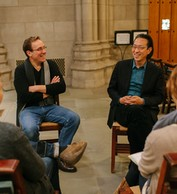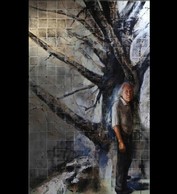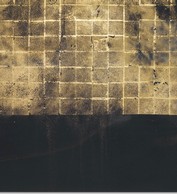STILLPOINT Archive: last updated 04/24/2013
By John Dixon Mirisola ’11
Some art endures not just as cultural relics or objects of beauty, but as sources of inspiration for future creations. “Generative art,” as Bruce Herman (Lothlórien Distinguished Chair in Fine Arts) calls these works, can live on in the minds of artists for decades, even centuries. Since World War II, few pieces of art have been as generative as T. S. Eliot’s Four Quartets—the inspiration for Herman’s current exhibition, QU4RTETS, a collaboration with renowned New York painter Makoto Fujimura, Yale composer Christopher Theofanidis and theologian Jeremy Begbie. QU4RTETS will be on exhibit through May 1 at the Gallery at Barrington Center for the Arts at Gordon College.
Herman first encountered Four Quartets in graduate school. In the fragmented unity of Eliot’s cycle of four poems, he discovered Eliot’s unforgettable blend of artistic tradition and stylistic innovation, philosophy and immediacy. Herman was captivated. These were the very elements that he wrestled with as a painter, working to stitch together classical techniques of figure painting with modern abstraction and discerning how to make art as a Christian, but not solely for Christians. In the four decades since, Herman has reread Four Quartets countless times, memorizing large swaths of text and expressing themes from Eliot’s poetry in many of his paintings.
Then in December of 2009, Herman discovered he was not alone in his affection for Eliot’s poetry. His friend and fellow artist Makoto Fujimura had been reading, memorizing, and painting Four Quartets in some way or another since just after the tragic events of September 11, 2001.
Their subsequent conversations laid the groundwork for what would eventually become QU4RTETS: four large works by each artist, accompanied by a collection of smaller ancillary works inspired by the poems, and a four-part musical score, “At the Still Point,” composed by Christopher Theofanidis. Prose by Jeremy Begbie appears in the exhibition catalog, completing the quartet of creative voices in the exhibition. The pieces are striking. Herman’s contributions, a series of portraits, address “an old painterly tradition: the Four Seasons and Four Stages of life (implicit in Four Quartets),” says the artist. Gridded with gold and silver foil, the paintings are suffused with light. “The reflective surface of the gold and silver shifts,” the artist explains, “bending the light and invoking that liquid, spiritual light in which we live and move and have our being—the quintessence or presence of God.”
Fujimura’s paintings, on the other hand are stark, minimalist, dark. “Bruce’s works clearly define space; mine would erase the boundaries. Bruce’s works introduce human characters and figures of various ages; mine are completely void of figuration,” Fujimura writes in the exhibition catalog. The resulting dialog between the two artists’ approaches mirrors the dualities expressed in Eliot’s poem: presence and absence, time and timelessness, darkness and renewal. Theofanidis’ score works at “reconciling” these dualities through variations in timing and tone, serving as a bridge between the visual aspects of the exhibition, tying the show together as a unified whole.
QU4RTETS has been on tour across the U.S. since November 2012, at Baylor University, Duke, and Yale. Following the exhibition at the Gallery at Barrington Center for the Arts, QU4RTETS will continue to tour throughout 2013 and into 2014, visiting additional galleries in the U.S. and international venues including Hong Kong University.
John Dixon Mirisola is a communications specialist in the Office of College Communications at Gordon.
Top image, from left: Bruce Herman and Makoto Fujimura
Center image: QU4RTETS No. 4 (Winter)
Bruce W. Herman, oil on wood with siulver and gold leaf, 97" x 60" (2012)
Bottom image: QU4RTETS III (detail)
Makoto Fujimura, mineral pigments and gold on Belgian linen, 50" x 80" (2012)


